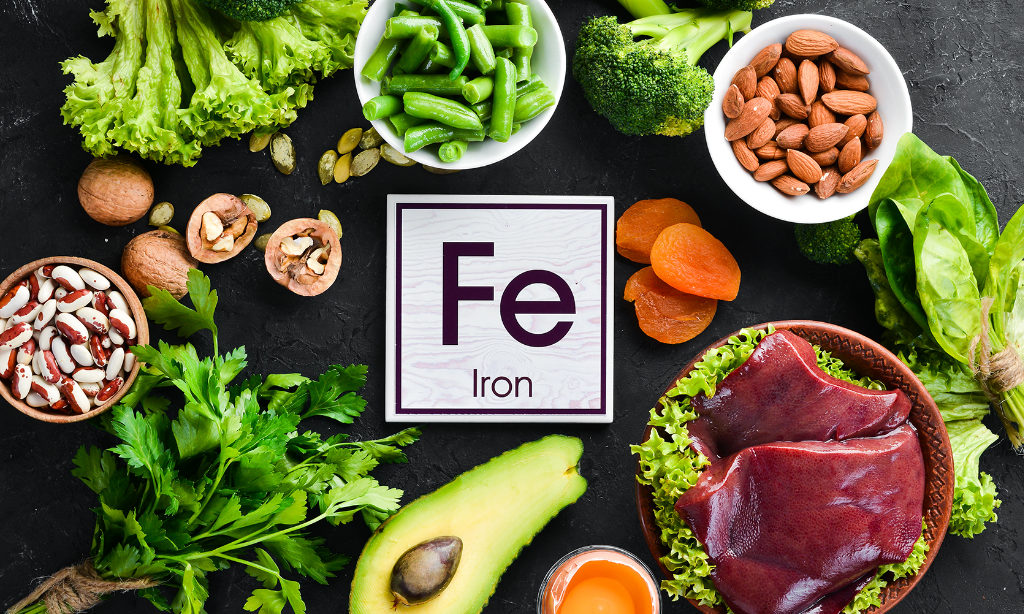Clients Feeling Zapped of Energy?

By Carol Harrison, RD
Iron is needed to carry oxygen to our cells.
Restrict the amount of oxygen to our cells, and it’s easy to see why going all out in a workout, (or even mustering up enough energy to get there in the first place), can be a challenge for your fitness participants and clients.
Good to know: Low energy and pale skin are classic signs of low iron. Other signs are less obvious: shortness of breath, irritability, headaches, susceptibility to infections – even brain “fog” and heart palpitations.
It’s not just elite “athletes” who are at risk for low iron.
Adolescent girls and adult women are at risk for low iron, especially those who workout regularly and intensely. The risk increases with:
- poor eating habits
- energy restricted diets
- long distance running (foot-strike hemolysis)
- vegetarian or vegan diets
- heavy menstrual flow
- frequent blood donation
- poor iron absorption (i.e., celiac disease, cancer)
Good to know: Vegetarians need to eat twice as much iron as non-vegetarians because the iron in plant foods is not absorbed as well by the body compared to animal foods. Athletes at greatest risk may need to be screened regularly for iron deficiency. Reversing iron deficiency can take three to six months, so prevention is key.
How much iron do we need?
| Age | Aim for (mg/d)* |
| Men 19 and older/ Women 50+ | 8 mg/day |
| Women 19-50 | 18 mg/day |
Good to know: Data from the 2015 Canadian Community Health Survey found the diets of 12-18% of Canadian women (14 – 50 years of age) were too low in iron. Given that female athletes may need up to 70% more iron than recommended, it’s likely that this percentage underestimates the prevalence of low iron amongst female athletes.
*Male and female athletes at greatest risk for low iron should aim for more than these amounts. A registered dietitian can provide individualized advice.
Not all food sources of iron are created equal.
Heme-iron from animal foods such beef, poultry, and seafood is 10 to 15 times more easily absorbed than non-heme iron found in plant foods such as extra-firm tofu, fortified pasta, Cream of Wheat, beans, lentils, nuts, seeds, and spinach.
For example, beef is one of the richest sources of iron, with a 100 g serving (deck of cards sized) providing 19% of our recommended daily intake for iron and it’s also heme iron, which is very well absorbed by the body.
Bottom line: Plant and animal sourced foods have different health benefits, so including a mix of both is ideal for general overall good health.
Food Sources of Iron
| Animal food sources of iron (75 g, cooked) | Amount of heme-iron (mg) |
| Beef liver | 4.9 |
| Beef, various cuts | 1.4 – 3.3 |
| Lean ground beef | 2.1 |
| Tuna, light, canned in water | 1.2 |
| Chicken, various cuts | 0.4 – 2.0 |
| Pork, various cuts | 0.5 – 1.5 |
| Turkey, various cuts | 0.3 – 0.8 |
| Lean ground chicken/turkey | 0.7 – 0.8 |
| Plant food sources of iron (cooked) | Amount of non-heme iron (mg) |
| Cream of Wheat, instant, ¾ cup | 3.0 |
| Lentils, ½ cup | 3.5 |
| Firm/extra firm tofu, 150 g | 2.4 |
| Kidney beans, ½ cup | 2.1 |
| Edamame, ½ cup | 1.9 – 2.4 |
| Nuts, ¼ cup (cashews, almonds, pistachio nuts) | 1.3 – 2.2 |
| Dried apricots, ¼ cup | 1.6 |
| Hummus, ¼ cup | 1.4 |
| Enriched pasta, ½ cup | 1.3 |
| Raw spinach, 1 cup | 0.9 |
Good to know: Adding some meat to meals can boost the amount of iron from plant sources by a whopping 150%. Adding vitamin C-rich foods to meals (tomatoes, peppers, broccoli, strawberries, and citrus) helps with iron absorption too. A bean and beef chili made with tomatoes makes for a tasty combination meal that optimizes iron uptake.
TAKE A FOOD-FIRST APPROACH TO GETTING ENOUGH IRON.
Routine, unmonitored iron supplementation is not recommended. Iron supplements can be costly, as well as causing nausea, vomiting, constipation, and diarrhea.
Be wary of supplements claiming, “Excellent source of plant-based iron” – while this may be true, the amount of iron absorbed by the body may not be adequate to meet needs.
If supplements are needed, a health care provider can recommend the type, dose, and timing to meet needs while easing any discomfort.

